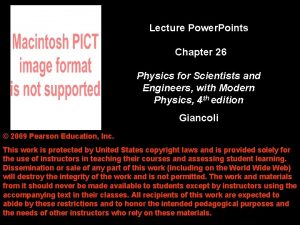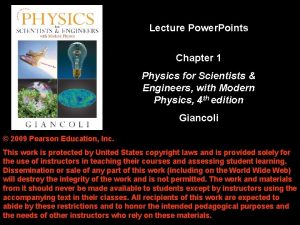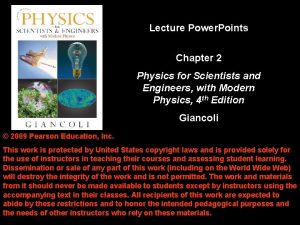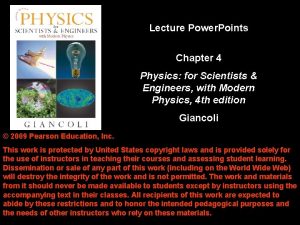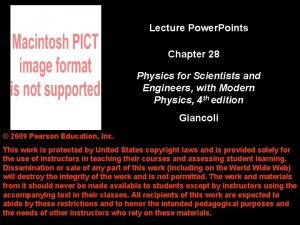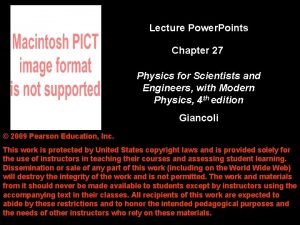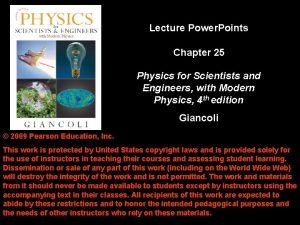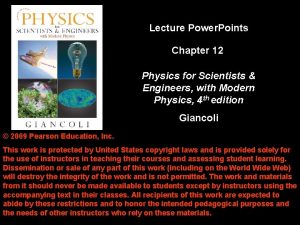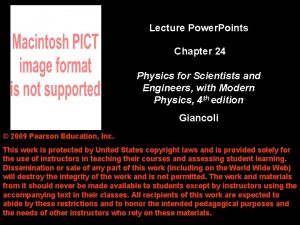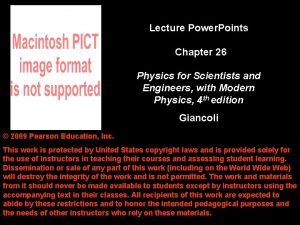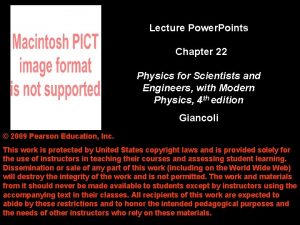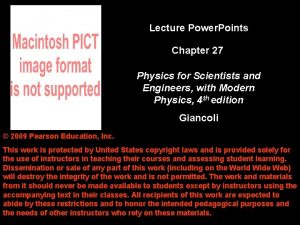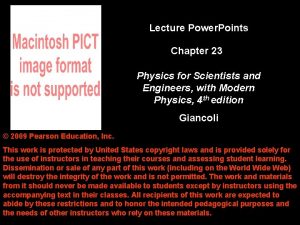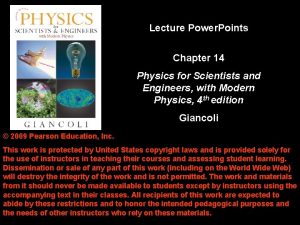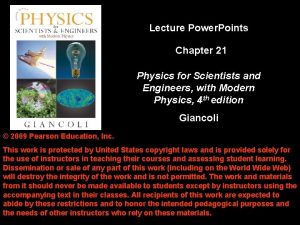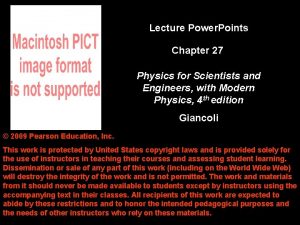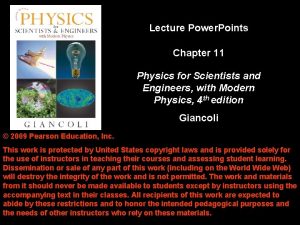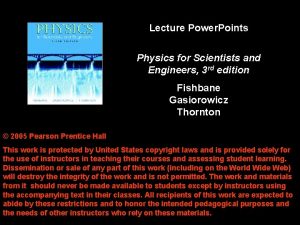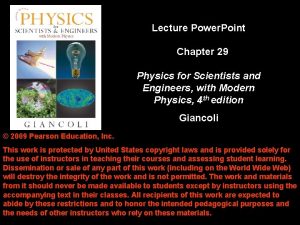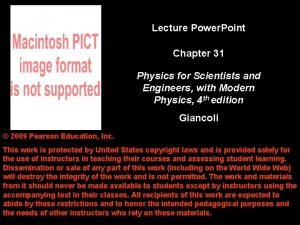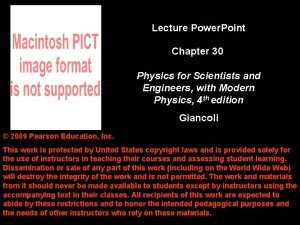Lecture Power Points Chapter 22 Physics for Scientists






















- Slides: 22

Lecture Power. Points Chapter 22 Physics for Scientists and Engineers, with Modern Physics, 4 th edition Giancoli © 2009 Pearson Education, Inc. This work is protected by United States copyright laws and is provided solely for the use of instructors in teaching their courses and assessing student learning. Dissemination or sale of any part of this work (including on the World Wide Web) will destroy the integrity of the work and is not permitted. The work and materials from it should never be made available to students except by instructors using the accompanying text in their classes. All recipients of this work are expected to abide by these restrictions and to honor the intended pedagogical purposes and the needs of other instructors who rely on these materials. Copyright © 2009 Pearson Education, Inc.

Chapter 22 Gauss’s Law Copyright © 2009 Pearson Education, Inc.

Units of Chapter 22 • Electric Flux • Gauss’s Law • Applications of Gauss’s Law • Experimental Basis of Gauss’s and Coulomb’s Laws Copyright © 2009 Pearson Education, Inc.

22 -1 Electric Flux Electric flux: Electric flux through an area is proportional to the total number of field lines crossing the area. Copyright © 2009 Pearson Education, Inc.

22 -1 Electric Flux Example 22 -1: Electric flux. Calculate the electric flux through the rectangle shown. The rectangle is 10 cm by 20 cm, the electric field is uniform at 200 N/C, and the angle θ is 30°. Copyright © 2009 Pearson Education, Inc.

22 -1 Electric Flux through a closed surface: Copyright © 2009 Pearson Education, Inc.

22 -2 Gauss’s Law The net number of field lines through the surface is proportional to the charge enclosed, and also to the flux, giving Gauss’s law: This can be used to find the electric field in situations with a high degree of symmetry. Copyright © 2009 Pearson Education, Inc.

22 -2 Gauss’s Law For a point charge, Therefore, Solving for E gives the result we expect from Coulomb’s law: Copyright © 2009 Pearson Education, Inc.

22 -2 Gauss’s Law Using Coulomb’s law to evaluate the integral of the field of a point charge over the surface of a sphere surrounding the charge gives: Looking at the arbitrarily shaped surface A 2, we see that the same flux passes through it as passes through A 1. Therefore, this result should be valid for any closed surface. Copyright © 2009 Pearson Education, Inc.

22 -2 Gauss’s Law Finally, if a gaussian surface encloses several point charges, the superposition principle shows that: Therefore, Gauss’s law is valid for any charge distribution. Note, however, that it only refers to the field due to charges within the gaussian surface – charges outside the surface will also create fields. Copyright © 2009 Pearson Education, Inc.

22 -2 Gauss’s Law Conceptual Example 22 -2: Flux from Gauss’s law. Consider the two gaussian surfaces, A 1 and A 2, as shown. The only charge present is the charge Q at the center of surface A 1. What is the net flux through each surface, A 1 and A 2? Copyright © 2009 Pearson Education, Inc.

22 -3 Applications of Gauss’s Law Example 22 -3: Spherical conductor. A thin spherical shell of radius r 0 possesses a total net charge Q that is uniformly distributed on it. Determine the electric field at points (a) outside the shell, and (b) within the shell. (c) What if the conductor were a solid sphere? Copyright © 2009 Pearson Education, Inc.

22 -3 Applications of Gauss’s Law Example 22 -4: Solid sphere of charge. An electric charge Q is distributed uniformly throughout a nonconducting sphere of radius r 0. Determine the electric field (a) outside the sphere (r > r 0) and (b) inside the sphere (r < r 0). Copyright © 2009 Pearson Education, Inc.

22 -3 Applications of Gauss’s Law Example 22 -5: Nonuniformly charged solid sphere. Suppose the charge density of a solid sphere is given by ρE = αr 2, where α is a constant. (a) Find α in terms of the total charge Q on the sphere and its radius r 0. (b) Find the electric field as a function of r inside the sphere. Copyright © 2009 Pearson Education, Inc.

22 -3 Applications of Gauss’s Law Example 22 -6: Long uniform line of charge. A very long straight wire possesses a uniform positive charge per unit length, λ. Calculate the electric field at points near (but outside) the wire, far from the ends. Copyright © 2009 Pearson Education, Inc.

22 -3 Applications of Gauss’s Law Example 22 -7: Infinite plane of charge. Charge is distributed uniformly, with a surface charge density σ (σ = charge per unit area = d. Q/d. A) over a very large but very thin nonconducting flat plane surface. Determine the electric field at points near the plane. Copyright © 2009 Pearson Education, Inc.

22 -3 Applications of Gauss’s Law Example 22 -8: Electric field near any conducting surface. Show that the electric field just outside the surface of any good conductor of arbitrary shape is given by E = σ/ε 0 where σ is the surface charge density on the conductor’s surface at that point. Copyright © 2009 Pearson Education, Inc.

22 -3 Applications of Gauss’s Law The difference between the electric field outside a conducting plane of charge and outside a nonconducting plane of charge can be thought of in two ways: 1. The field inside the conductor is zero, so the flux is all through one end of the cylinder. 2. The nonconducting plane has a total charge density σ, whereas the conducting plane has a charge density σ on each side, effectively giving it twice the charge density. Copyright © 2009 Pearson Education, Inc.

22 -3 Applications of Gauss’s Law Conceptual Example 22 -9: Conductor with charge inside a cavity. Suppose a conductor carries a net charge +Q and contains a cavity, inside of which resides a point charge +q. What can you say about the charges on the inner and outer surfaces of the conductor? Copyright © 2009 Pearson Education, Inc.

22 -3 Applications of Gauss’s Law Procedure for Gauss’s law problems: 1. Identify the symmetry, and choose a gaussian surface that takes advantage of it (with surfaces along surfaces of constant field). 2. Draw the surface. 3. Use the symmetry to find the direction of E. 4. Evaluate the flux by integrating. 5. Calculate the enclosed charge. 6. Solve for the field. Copyright © 2009 Pearson Education, Inc.

22 -4 Experimental Basis of Gauss’s and Coulomb’s Laws In the experiment shown, Gauss’s law predicts that the charge on the ball flows onto the surface of the cylinder when they are in contact. This can be tested by measuring the charge on the ball after it is removed – it should be zero. Copyright © 2009 Pearson Education, Inc.

Summary of Chapter 22 • Electric flux: • Gauss’s law can be used to calculate the field in situations with a high degree of symmetry. • Gauss’s law applies in all situations, and therefore is more general than Coulomb’s law. Copyright © 2009 Pearson Education, Inc.
 01:640:244 lecture notes - lecture 15: plat, idah, farad
01:640:244 lecture notes - lecture 15: plat, idah, farad Power trianlge
Power trianlge Bull's eye brand positioning
Bull's eye brand positioning Points of parity and points of difference
Points of parity and points of difference Classical mechanics
Classical mechanics Physics 101 lecture notes pdf
Physics 101 lecture notes pdf Phy101 lecture 1
Phy101 lecture 1 Physics 101 lecture notes pdf
Physics 101 lecture notes pdf Waves pdf download
Waves pdf download Atmospheric physics lecture notes
Atmospheric physics lecture notes Power system dynamics and stability lecture notes
Power system dynamics and stability lecture notes Power system analysis lecture notes
Power system analysis lecture notes Power semiconductor devices lecture notes
Power semiconductor devices lecture notes Switch mode power supply lecture notes
Switch mode power supply lecture notes Power system dynamics and stability lecture notes
Power system dynamics and stability lecture notes Prayer of authority
Prayer of authority Why does it happen
Why does it happen University physics with modern physics fifteenth edition
University physics with modern physics fifteenth edition Physics ib ia ideas
Physics ib ia ideas Fspos
Fspos Novell typiska drag
Novell typiska drag Tack för att ni lyssnade bild
Tack för att ni lyssnade bild Vad står k.r.å.k.a.n för
Vad står k.r.å.k.a.n för























